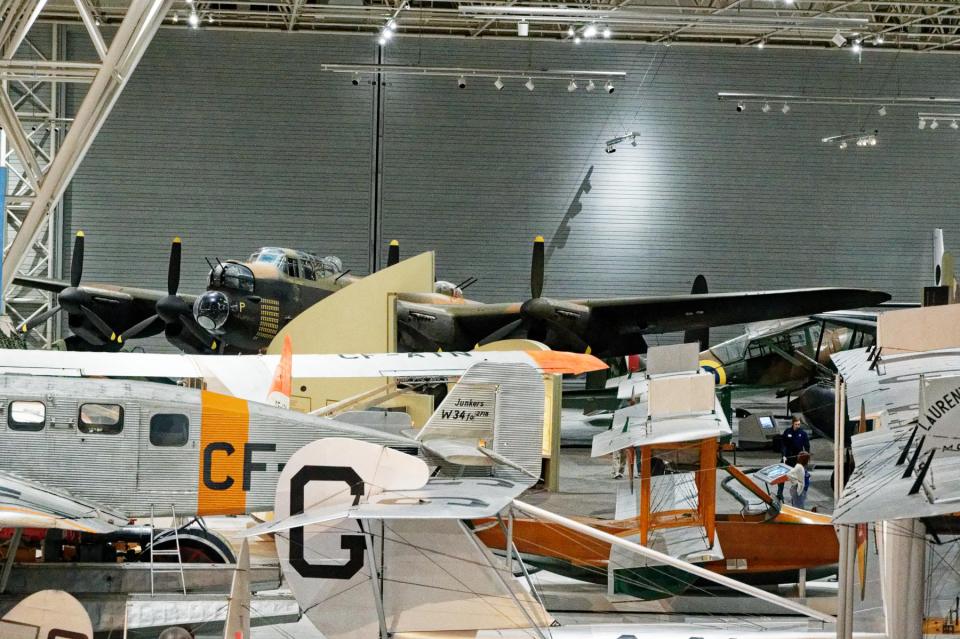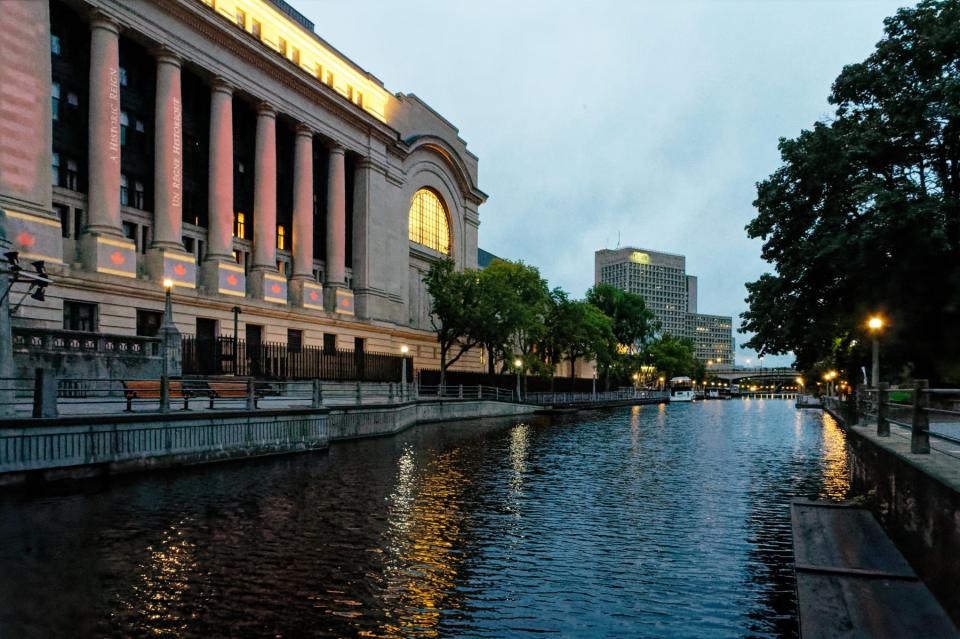Monday September 19 2022 – The day started and ended with something warm and familiar – a Nice Cup Of Tea (Twinings Earl Grey, courtesy of St. Lawrence Market in Toronto). In between those comforting landmarks, there was a distinct culture shift as we headed to Québec City.
The Via Rail experience was broadly similar to that of our journey into Ottawa: masks were required at all times in station and train, unless actually eating or drinking (even between sips of a drink, according to the stern-sounding MC shortly after we set off); food and drink were served at our comfortable seats; power and WiFi were available throughout the journey; and we arrived about half an hour late. The differences were subtle, though marked: the ham and omelette served for breakfast were both very odd creations; the WiFi worked for some websites (including, fortunately, this one) but not others (including my banking app, so I couldn’t check on whether the Ottawa hotel had really given us free internet access); and our suitcases were checked in, rather than accompanying us in the carriage. Oh, and the weather wasn’t all that brilliant, either, but then we were on a train, so didn’t really mind.

On the journey, Jane saw more churches with what looked like silver spires

(reminiscent of Notre Dame in Ottawa). The explanation will be forthcoming tomorrow, by the way, so please continue to pay attention.
But then we arrived in Québec city, and it was obvious that we had qrossed a qultural qhasm: we might as well have been in Paris. The atmospheric change affected the passengers, whose previous orderly behaviour descended into an amorphous mob grabbing at their luggage as it came off the baggage car; initial signs directing passengers to taxis evaporated, leaving those in need of transport baffled as to where to go; a young lady at an “information” desk couldn’t be arsed to do more than hold up a piece of paper with a taxi phone number on it; and the taxi rank (once we discovered it, indicated by a scruffy and not very prominent sign attached crookedly to a lamppost hidden behind a construction site) was devoid of taxis. After all the orderly, North American and well-organised travels of the last six weeks, it was a distinctly European experience.
Eventually, taxis started appearing and the ragged queue that had rather grudgingly formed with a puzzled expression on its collective face, started being transported to its destinations. The sophistication of the local taxi network was laid bare as our taxi driver stopped at one point to shout at another taxi that he should go to the station as it was “plein” (full), and reinforced as he explained that he’d prefer us to pay cash – the first time we had actually had to use Canadian banknotes in a month and a half. Oh, how we chuckled!
The Parisian feel continued as we arrived at our hotel (yet another Fairmonster, the Chateau Frontenac)

whose front yard was littered with vehicles (Gawd alone knows how our taxi driver got out). Once inside, we had a choice of what might or might not have been three separate queues, any of which might or might not have led to a point where we might or might not have been able to check in, amid scenes of fairly voluble and rather unco-ordinated discussions going on all around us. We took the only course of action one can under these circumstances, which is to stand separately in two of the least unpromising-looking queues, ready to spring to the other in case it was a more effective choice. In the end, and completely by accident, I won. I saw a couple of people apparently jump all of the available queues and decided that I should follow this very Parisian example; it turned out that they’d found the Fairmont Loyalty Card queue and since I have an Accor membership I was able to find someone prepared to help us.
Once that had happened, everything proceeded a lot more smoothly. We got a nice room (rather reminiscent of Jane’s Parisian garret apartment of 30 years ago) on the seventh floor, and the last Parisian snook cocked at us was that we were charged by a hotel room service jobsworth for some milk for the cup of tea we were really in need of by this stage. This is our eighth Fairmont; none of the previous seven have cavilled at simply – and freely – helping out a couple of Brits in pitiful need of tea. But we were now in logical Paris, so not only were we charged for a glass of milk, but, of course, there was a delivery cost added to the bill.
Anyhoo….
It was late afternoon by this stage and so we decided to go for a walk. Obviously. We (broadly) followed a recommendation from Ian Burley (you’ll remember – of course! – that we met him as we walked around Menorca a year ago) for a stroll around parts of the city. The walk started on the terrace outside the hotel

which also gives an opportunity to see quite what a monster the hotel is. The terrace is a pleasant boardwalk in a nice environment

with the occasional surprise, like this toboggan run (winters only, of course)

and, at the end, a really quite substantial set of steps up to Quebec’s Citadel.


Our route took us across the Plains of Abraham (no, not that one, actually; more likely a Scottish fisherman who came here early in the 17th century) which were the scene of a battle between perfidious Albion and those diabolical Frenchies in 1759 as the two nations struggled for control of an extremely important strategic location. Then we went past the National Assembly building

(very imposing, and much more pleasant on the eye than the government buildings opposite),

and one of the historic gates into the city (St. Louis Gate).

It was almost impossible for me to shake off the feeling of being in Paris. On one side of the street you could find a charming row of houses and brasseries,

and, directly opposite, great brutalist slabs of masonry;

inexplicable bits of statuary;

attempts to disguise, with a mural

a ghastly block of modern masonry;

and some really charming buildings.

We ended up walking along the Rue St. Jean, sadly by now in the dark, as it looks like it would be really interesting to see in the daylight, past the building site outside the cathedral and back towards the hotel. Québec is clearly going to be an interesting place to look around



despite the appalling solecism of having a Christmas Shop.

This was one of the giveaways that we were not, actually, in Paris; the other was that walking along Rue St. Jean was accompanied by the smells emanating from innumerable popcorn and ice-cream parlours – an ineluctable part of being anywhere near retail establishments in North America.
All in all, it was a pleasant and interesting introduction to somewhere which clearly has a great deal of historical interest to accompany its undoubted charm. We will hardly scratch the surface in our forthcoming two days here, but it’ll be nice to aim for some degree of insight.
Tomorrow, we are promised, on our itinerary, “A Fabulous Country Tour” and, by the weather forecast, wind and rain. Who knows how it will go? Answer: you will, but only if you check back in to these pages to find out.

























































 (above imaginatively called “Bear Catching Fish)
(above imaginatively called “Bear Catching Fish)
 (The above is called “Our Shepherds”. The accompanying description says “The playful blue colour and simple, symmetrical structure of the sculpture acts as an enticement to consider deeper meanings. Our Shepherds speaks of those who take power and those who are led, inviting viewers to question who are the shepherds and who are the sheep.” This is a load of pretentious bollocks in my view.)
(The above is called “Our Shepherds”. The accompanying description says “The playful blue colour and simple, symmetrical structure of the sculpture acts as an enticement to consider deeper meanings. Our Shepherds speaks of those who take power and those who are led, inviting viewers to question who are the shepherds and who are the sheep.” This is a load of pretentious bollocks in my view.) (A representation of The Stanley Cup, the Canadian ice-hockey trophy)
(A representation of The Stanley Cup, the Canadian ice-hockey trophy)
 (Maman, outside the Arts Museum and across the road from Notre Dame)
(Maman, outside the Arts Museum and across the road from Notre Dame) (a cute advert for a bicycle rental establishment)
(a cute advert for a bicycle rental establishment) (York Street Steps)
(York Street Steps)



















